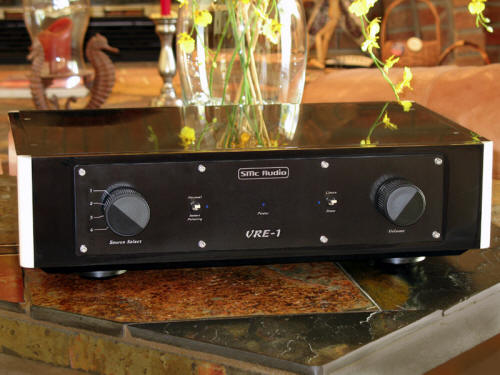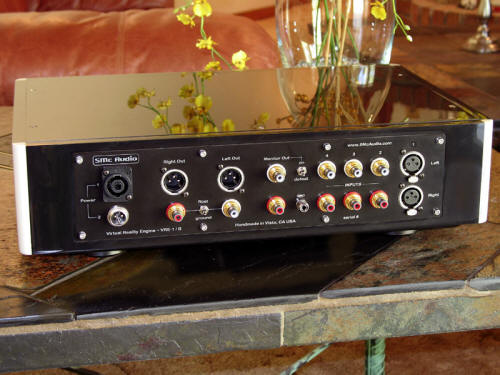
You are reading the older HTML site
Positive Feedback ISSUE
may/june 2008
smc audio
VRE-1 preamplifier - The Virtual Reality Preamplifier
as reviewed by Jim Merod

|
JIM MEROD'S SYSTEM
LOUDSPEAKERS
ELECTRONICS
SOURCES
CABLES
ACCESSORIES |
On the criminal background; the first heist...
I've written about the prototype version of Steve McCormack's recently debuted VRE-1 (Virtual Reality Engine) preamplifier. I was so taken by its sonic invisibility and musical elegance that I called upon the best collegial instincts of its designer to fork that box over. I, in turn, forked over cash moola that it well deserved in acknowledgement of its state of the art pedigree and my awareness that my "Lady Day" version was an instant classic, a one-of-a-kind musical instrument.
I've been pleased to the maximum ever since. I've chuckled once or twice with that muffled guilty gurgle in the throat that designates barely contained delight that one has pilfered the last cookie in the jar. The Lady Day is a royal audio personage who has given enormously generous musical companionship. My barely muffled delight is both well-earned and well rewarded. My audio universe improved immensely the moment it slipped into its welcome place on my Grand Prix shelf.
However, there's a fly on this windshield. Cruising along grandly, with nothing but untrammeled musical joy, is a sure invitation to exuberance and the sober aftermath all euphoria breeds.
McCormack brought his VRE-1 drop-dead beautiful Corian chassis, considerably advanced version, to the market coincident with the year's opening show, CES in Las Vegas. I heard from a number of people stalking the Venetian's halls that they were looking forward to getting a direct scoop on that box because nothing convinces a well-trained audiophile like immediate evidence. Hearing is belonging (horen = gehoren... the Germans are correct), thus some of these folks told me they trekked into the McCormack suite hoping to get their fix. The same blokes reported that age-old CES bewilderment ensued. To wit, it's damn hard to get a sound system tricked into maximum sonic luminosity in a room built for "Maude and Harold's big Las Vegas adventure." Many once a year musical dreams have died in the Venetian this year and, before that, in Alexis Park and St. Tropez rooms built to welcome a bevy of airline employees and their momentary partners. It just works that way.
So, thinking that I'd be willing to get the scoop on this technical partner to my Lady Day, I signed up for the gig. Voila! My adorable colleague, Maestro Robert Levi, beat me to the assignment. His observations and thoughts are already posted here, but mine below follow the great man's discriminations as an immediate aftermath. The VRE-1 now going back to its designer was still warm with Maestro Levi's paw prints when he handed it over to me.
WHOA (in spades)!
It's not that I want to trade my amazing Lady Day, back for credit against the purchase of this ridiculously good looking and even better sounding box. But the thought has crossed my mind because the VRE-1 is so utterly "not there" in the signal path. It is so fully seductive in its invisible, untrammeled sonic permission—an essentially paradoxical technical tandem of musical erotic's and ghostly disappearance—that one sits before its glorious outcome and marvels both at music delivered more faithfully than ever and aesthetic love-making with no one and nothing.
Think of the spookiness of that experience. It took me awhile to overcome the pleasurable weirdness of it all. On one hand, better sound; more musicality; more complete transient delicacy; firmer instrumental placement; more engaging timbral textures …and the other hand, the palpable sense that an essential element of the entire musical event (the technical network itself) had dissolved entirely. With the VRE-1, music seems to "appear" out of nowhere and yet very much within the actual physical and acoustic context in which it was created. I've heard further into the actual three dimensional "stage" of mind boggling (perfectly in phase and thus hugely wide) recordings than ever previously. Stan Kenton's beautifully recorded late-'50s big band—with three killer horn sections—leaps and groans and gallops as never before, How do so many dead men come alive so credibly? The VRE-1 has a touch that revives the deceased and allows previous audio glory to achieve its complete sonic spectrum.
Goofing with gear
I decided to throw a variety of input sources at the VRE-1 since, on one hand, it has extraordinary compatibility and, on the other, the potential for revealing near-field sonic differences.
I was most interested in hearing how the KORG MR 1000 super high-resolution field recorder would sound pumped through this box. The KORG has the ability to record at a data rate twice the SACD standard. Since I had several live recording sessions curled in wait on the KORG's generous internal hard drive (recorded at its ultimate level of resolution), it seemed right as well as intriguing to give these pieces of gear a tandem work out.

I can, without fear of contradiction, say that the KORG is all it's cracked up to be: a truly state of the art, high capacity two channel recorder essentially without inexpensive equals. The VRE-1 seemed pleased to offer so much dynamic range and sonic detail. The match between these musical champions was effortless and genuinely obvious—as if their mating was pre-ordained. What struck me most about it was the utter simplicity of sonic command that occurred instantly. Such "command" is in large part a result of relaxation in the sonic chain: musical presentation with no heaving or edge or grain or sense of acoustic constriction. Although the music was extremely high digital data rate transfer, its aesthetic outcome was more nearly like vinyl at its ultimate degree of resolution.
I suppose what struck me most about the VRE-1's uniquely large, deep soundstage was the absolute precise placing of instruments upon a rich textural three-dimensional sonic field that "appeared" to BE the exact place where each recording took place. I'm pointing here to an extra-musical element of live recordings, but an element that nonetheless participates greatly in the illusion of "thereness" that on location recordings carry at their maximum best. I do not mean to dismiss or diminish the dynamic force and timbral nuances that seem so integral to the VRE-1's aesthetic pedigree. Nor am I overlooking the vivacity of attack on, say, Dan Papaila's solo guitar or the luxurious ambient decay of Gilbert Castellanos' open valve "air" notes in his amazing (and beautifully eccentric) rendering of Nat Cole's "Nature Boy." All that was present, in graphic sonic spades. But, damn …the way the VRE-1 "captures" or, more accurately, "reproduces" the smallest elements of concrete musical space—reverberation; bodily presence; breath; room height and width and depth: that is, for an old recording maverick with thousands of hours of musical trekking and all the sonic scars that verify it, a touch of nirvana. Spooky. Elusive. Like Cezanne's magic painterly "glow from out of nowhere."
Great music never dies
Similar, if less dramatic, outcomes followed when I connected the Tascam RA1000 and the Alesis 9600 Masterlink recording machines to the McCormack VRE-1: more detail; more relaxation; more soul-involving music …more of everything anyone who loves great sound and better music cares about.
The most difficult aspect to describe about musical reproduction occurs when music seems "real," as if created directly before your hungry ears …as if the music is not recorded but in process, being played in real time as you hear it. Many elements must come together for that to occur. The recording must be special. The speakers must be up to the task of offering a seamless, perfect dynamic rendering if signals delivered by superior amplification. The cables must be "in sync" with the signal load at every point in the delivery path. And the preamp must be self-effacing with a noble invisibility (inaudibility) and "touch" that is just plain rare, at best, and (for this witness) almost never closely approximated. That "musical reality" is in constant play with the VRE-1 anytime a recording worthy of its extraordinary resolving power initiates its signal chain.
It pains me to say, in virtual agreement with Bob Levi, that I've never heard a more noble or stunning or better preamplifier. Bob has made extraordinarily precise discriminations in this regard and I urge anyone who cares enough about this issue to read Bob's very well-crafted, extremely detailed review. The VRE-1 is, by far, the most musical preamp I've heard. It is, far and away, the most "engaging" preamp I've ever lived with for an extended length of listening time. It deserves every dollar of its modestly priced (but not inexpensive) $7500.
My dilemma now is just like every other red-blooded audiophile's: how much to spend on musical nirvana, sonic magic? I think I know the answer already. It's nearly tragic that an audio instrument of this nuanced seductiveness emerges just as the larger economy tanks and many devoted audio adventurers must pull back to rethink their financial leverage. For me, if only one improvement can be made in this uncertain economic environment, then the VRE-1 is the one. I'll count my pocket change, talk with the Little Lady, and alter my weekly schedule so more listening time with such enhanced sound can justify my investment.
It's that time of spring again, Shakespeare's birthday—a good day to celebrate bardic glory with superior musical glory. Jim Merod
SMc Audio
929 El
Pajodo Place
Vista, CA 92084
TEL: 760. 732. 0352
web address:
www.SMcAudio.com
email address:
[email protected]
